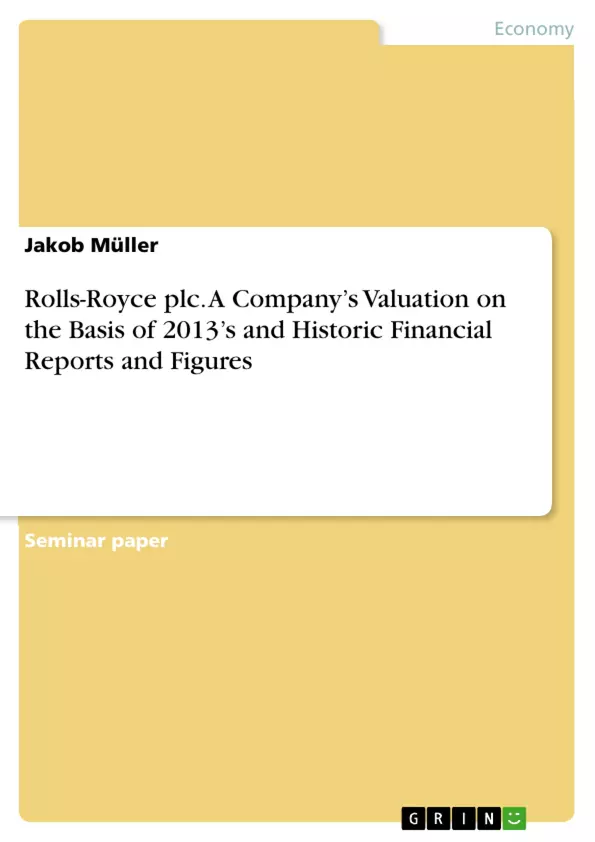Estimation of the cost of equity capital for Rolls-Royce plc using the Capital Asset Pricing Model (CAPM), the Market Derived Pricing Model (MCPM) and the Dividend Valuation Model (DVM). Comment on the potential sources of error in the estimate and reasons why the three models give different results.
Analysis of the financial accounts as at year end 31 December 2013 noting the five most important financial issues faced by the company and how they are being resolved by the company
Forecast of the revenues for the next five years for Rolls Royce using the most up to date information available relevant to the company.
Forecast of the earnings per share and dividend per share for Rolls Royce assuming dividends grow at 8% per annum and using the equity cost of capital from chapter 1. Estimation of the equity share value of the company.
Estimation of the value of an ‘at the money’ call option for Rolls Royce using the Black & Scholes Option Pricing Model.
Table of Contents
- Cost of Equity Capital
- Financial Issues
- Revenue Forecast
- Forecast of Earnings and Dividend per Share
- Call Option Estimation
Objectives and Key Themes
The objective of this analysis is to estimate the cost of equity capital for Rolls-Royce plc using three different models: the Dividend Valuation Model (DVM), the Capital Asset Pricing Model (CAPM), and the Market Derived Capital Pricing Model (MCPM). The analysis aims to compare the results obtained from each model and discuss the potential sources of error.
- Cost of Equity Capital Calculation using various models
- Comparison of results from different valuation models
- Analysis of potential sources of error in estimations
- Application of Discounted Cash Flow (DCF) methodology
- Incorporation of market data and risk factors
Chapter Summaries
Cost of Equity Capital: This chapter delves into the calculation of Rolls-Royce plc's cost of equity capital using three distinct models: the Dividend Valuation Model (DVM), the Capital Asset Pricing Model (CAPM), and the Market-Derived Capital Pricing Model (MCPM). The DVM, a straightforward DCF approach leveraging historical dividends, yields a cost of equity of 11.21%. The CAPM, incorporating beta (calculated using OLS regression of Rolls-Royce share prices against the FTSE ALL-SHARE index) and market risk premium (derived from DCF applied to market dividends), produces a cost of equity of 8.2%. Finally, the MCPM, focusing on future volatility from options markets and accounting for national confiscation, corporate default, and equity return risks, offers a third perspective. The chapter highlights the inherent differences and potential sources of error in each model, stemming from data limitations and differing assumptions about future growth and risk. The variations in results underscore the complexities and nuances of equity valuation.
Keywords
Rolls-Royce plc, Cost of Equity Capital, Dividend Valuation Model (DVM), Capital Asset Pricing Model (CAPM), Market Derived Capital Pricing Model (MCPM), Discounted Cash Flow (DCF), Beta, Risk Premium, Equity Valuation, Financial Modeling.
Rolls-Royce plc Equity Valuation Analysis: Frequently Asked Questions
What is the purpose of this analysis?
This analysis aims to estimate the cost of equity capital for Rolls-Royce plc using three different models: the Dividend Valuation Model (DVM), the Capital Asset Pricing Model (CAPM), and the Market Derived Capital Pricing Model (MCPM). The goal is to compare the results and discuss potential sources of error in each approach.
What models are used to estimate the cost of equity capital?
The analysis employs three models: the Dividend Valuation Model (DVM), the Capital Asset Pricing Model (CAPM), and the Market-Derived Capital Pricing Model (MCPM). Each model offers a different perspective on calculating the cost of equity, incorporating varying assumptions and data inputs.
What are the key themes explored in this analysis?
Key themes include the calculation of the cost of equity capital using various models, a comparison of results from these different valuation models, an analysis of potential sources of error in the estimations, the application of Discounted Cash Flow (DCF) methodology, and the incorporation of market data and relevant risk factors.
How does the Dividend Valuation Model (DVM) estimate the cost of equity?
The DVM, a straightforward DCF approach, utilizes historical dividend data to estimate the cost of equity. In this analysis, the DVM yielded a cost of equity of 11.21% for Rolls-Royce plc.
How does the Capital Asset Pricing Model (CAPM) estimate the cost of equity?
The CAPM incorporates beta (calculated using OLS regression of Rolls-Royce share prices against the FTSE ALL-SHARE index) and market risk premium (derived from DCF applied to market dividends) to determine the cost of equity. This model produced a cost of equity of 8.2% for Rolls-Royce plc.
How does the Market-Derived Capital Pricing Model (MCPM) estimate the cost of equity?
The MCPM focuses on future volatility derived from options markets and accounts for risks such as national confiscation, corporate default, and equity return risks. It provides an alternative perspective on the cost of equity calculation.
What are the potential sources of error in these estimations?
The analysis highlights that variations in results across the models stem from inherent differences in methodologies, data limitations, and differing assumptions about future growth and risk. Data limitations and the assumptions made about future growth and risk are significant sources of potential error.
What are the key findings of the chapter on the cost of equity capital?
The chapter on the cost of equity capital reveals significant differences in the cost of equity estimates generated by the three models (DVM, CAPM, and MCPM), emphasizing the complexity and nuances inherent in equity valuation and the importance of considering multiple valuation approaches.
What are the key words associated with this analysis?
Key words include Rolls-Royce plc, Cost of Equity Capital, Dividend Valuation Model (DVM), Capital Asset Pricing Model (CAPM), Market Derived Capital Pricing Model (MCPM), Discounted Cash Flow (DCF), Beta, Risk Premium, Equity Valuation, and Financial Modeling.
- Quote paper
- Jakob Müller (Author), 2014, Rolls-Royce plc. A Company’s Valuation on the Basis of 2013’s and Historic Financial Reports and Figures, Munich, GRIN Verlag, https://www.hausarbeiten.de/document/294930


